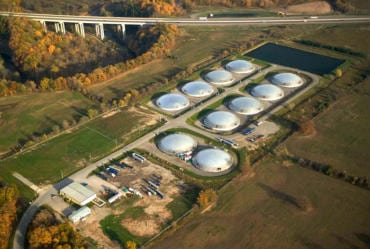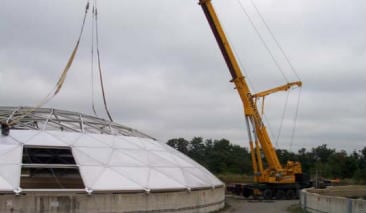[precontent]
[two_third valign=”middle” animation=”none]
Solving a Messy Problem: Covering Wastewater Treatment in Halton Region Ontario, Canada
[/two_third]
[one_third_last valign=”middle” animation=”none”]
[button linking=”default” align=”center” size=”big” style=”simple” type=”wide” link=”http://www.cstindustries.com/request/”]Inquiry[/button]
[/one_third_last]
[/precontent]
The Regional Municipality of Halton or Halton Region is located in Southern Ontario, part of the greater Toronto area. Halton owns and operates seven wastewater treatment plants for four Ontario cities in its jurisdiction.  These plants are designed to treat wastewater from homes and businesses turning the effluents into biosolids. Turning waste into food requires a process that starts with the liquid primary treatment and concludes with a solid fertilizer distributed among the farmers in the area.
These plants are designed to treat wastewater from homes and businesses turning the effluents into biosolids. Turning waste into food requires a process that starts with the liquid primary treatment and concludes with a solid fertilizer distributed among the farmers in the area.
Tanker trucks haul biosolids from the seven plants to a central location in order to provide storage during the winter and early spring. Just before the material is sent to the farmers, a mixing process distributes the materials that may have settled during storage. In the spring, over one hundred trucks may be on the roads delivering this fertilizer to various farms in the Halton region.
Somewhat of a misnomer, a biosolid is actually a liquid. When the material is delivered to the farm, it is injected in to the soil in order to reduce runoff and deliver the fertilizer to the appropriate depth for the specific crop. These biosolids are approximately 2.5 percent to 5 percent solid and delivers a valuable source of nitrogen, phosphorous and organic matter necessary for healthy farming. This sustainable, waste to food practice is a cyclical and sustainable initiative sponsored by the municipalities.
Biosolids are rich in the nutrients listed as well as trace amounts of copper, iron, molybdenum and zinc that are used to enrich farm fields and promote food growth. Citizens were concerned that the biosolid initiative would also lead to pollution. In response to citizen concerns about the safety of this fertilizer, Halton provides a websitei describing the protocols for testing and monitoring this resource.
The Halton Region is required to meet the regulations from the Ontario Water Resources Act, The Environmental Protection Act and the Nutrient Management Act. These provisions outline the requirements that provide the assurance that food quality and human, animal and environmental health’s are protected. Based on decades of scientific research, Canadian regulatory agencies such as the Ministry of the Environment, the Ministry of Agriculture and Food, and the Ministry of Health and Long-term Care have concluded that the use of biosolids are a safe, responsible and sustainable practice in Ontario.
Since 1979, this recycling of wastes has provided biosolids to farmers, both as liquid and solid fertilizers with no reported illnesses with biosolid applications. By providing this resource, the community has supported farmers economically as they are saving them the cost of purchasing commercial fertilizers.
Turning waste into fertilizer requires that wastewater be heated and stored for one-month while being treated through a biological process. This process stabilizes the wastewater to the point where there is very little additional biological activity eliminating most pathogens. Remaining pathogens are reduced when exposed to air and when used as fertilizer.
In order to reduce any concerns that groundwater may be affected by the introduction of biosolids to farm fields, there are rules that govern the distance from any open waterways, wells, the depth of soil as well as the height of the water table. Although there are some odors associated with this fertilizer, there are few complaints. As described above, the biosolid is incorporated into the fields by injections and plowing into the soil.
In 1985, the W.A. Bill Johnson Biosolids Management Center was constructed as a central receiving point for the consolidation of the seven wastewater treatment plants in Halton, Ontario. By 1998, the facility contained ten concrete tanks, lined with a high-density polyethylene membrane liner embedded in sand, gravel and monitored for leaks on a regular basis. The treatment of waste into biosolids included the distribution of the waste as a free source of fertilizer to local farmers.
The large storage tanks were designed with high-density polyethylene floating covers attached to the top of the concrete sidewalls with a flexible side skirting.  Each time tanks were filled or emptied, this material was subjected to friction and required frequent and costly repairs. The cover deflated into the tank floor when it was emptied which made it hard, if not impossible to provide regular tank cleanouts and floor inspection without adding more maintenance costs.
Each time tanks were filled or emptied, this material was subjected to friction and required frequent and costly repairs. The cover deflated into the tank floor when it was emptied which made it hard, if not impossible to provide regular tank cleanouts and floor inspection without adding more maintenance costs.
Greatario Engineered Storage Systems was contacted to evaluate the storage tanks and along with a consultant chose to use aluminum replacement domes as the new system for the existing tanks. Each tank, which varied in size, was custom designed with a pre-engineered dome using aluminum structural and skin components, stainless steel fasteners and silicone sealant. Dome dormers and working platforms added to the structures provided safe access into the tank and the mixing equipment. Not only was this solution a means for greater inspection of the biosolid process, they also meant that the floors and tanks could be emptied and maintained on a regular basis.
Because of the advantages of a lightweight system, the initial domes were constructed onsite and lifted by crane into position. However, when the engineer ran out of room, they provided an innovative construction alternative, building the domes from inside the tanks and on top of floating “barges” to avoid damaging the liner in the storage tanks. The engineer used the material properties of aluminum to reduce cost, save labor and provide a non – corrosive solution for this difficult problem. Meeting the needs for biosolid storage, these covers prevent moisture from entering the tanks, while reducing maintenance and repair costs.
Benefits of CST’s Aluminum Dome Covers:
- Corrosion Resistance: Aluminum is inherently corrosion resistant compared to other materials. It will last the lifetime of the structure and will not need to be painted or repainted for protection from the elements.
- Low Lifetime Maintenance Cost: With no need to maintain a protective finish to prevent corrosion over time, there are little-to-no maintenance costs associated with an aluminum dome.
- Clear-Span Capability: Aluminum’s lightweight characteristics allow for larger clear-span cover capability than structures utilizing steel, concrete and other materials.
- Fast & Low-Cost Construction: Creative design and lightweight components provide for installation in 1/3 the time it takes to install other cover systems. Less time, labor and equipment needs combine for a low total cost of installation.
- Design Flexibility: Aluminum’s excellent strength-to-weight ratios and creative component designs yield covers and structures that cannot be achieved with other materials.
- Aluminum is a “Green Material”: Not only are aluminum cover systems recyclable after their service life, but more than 50% of the aluminum used in the cover systems is made from recycled aluminum.
Contact Information:
[one_half]
CST Industries, Inc.
844-44-TANKS
[email protected]
[/one_half][one_half_last]
Greatario Engineered Storage Systems
866-299-3009
[email protected]
[/one_half_last]
